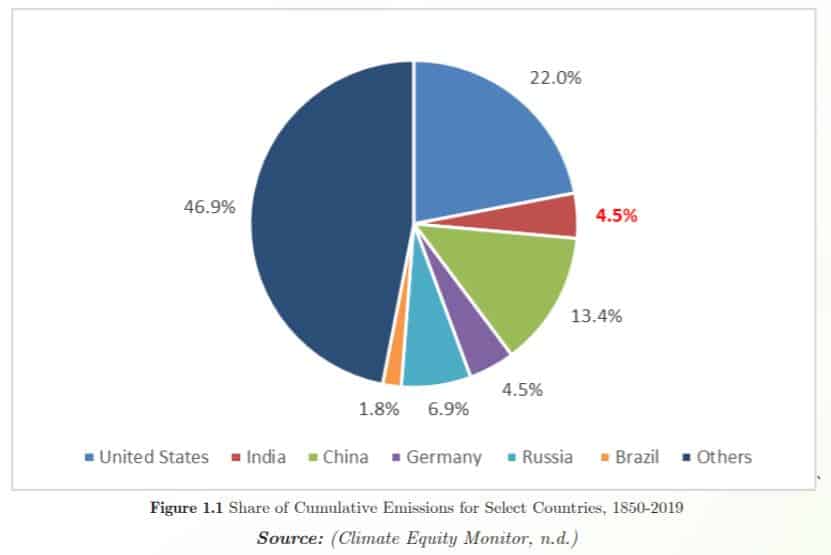India submitted its long-term climate strategy at the COP27 summit underway in Egypt, joining a selected list of countries that have clear pathways on how to achieve their net zero goals.
Under the Paris Agreement, all countries have to submit by 2020 a climate strategy to the UN Framework Convention on Climate Change (UNFCCC) detailing how they’ll help fight global warming. These plans are called the Long-Term Low Emissions and Development Strategies (LT-LEDS).
So far, only 57 nations have submitted their LT-LEDS and India is the last of the biggest emitters to do so.
Unlike Nationally Determined Contributions (NDCs), LT-LEDS focus on a longer time horizon. Countries don’t have to report progress on their long-term climate plans as the case with NDCs.
The world’s second-largest consumer of coal aims to prioritize a phased transition to cleaner fuels. It will also reduce household consumption to reach net zero emissions by 2070, according to its 100-page low-carbon strategy.
Minister for Environment, Forest and Climate Change Bhupender Yadav launched the country’s LT-LEDS, saying that:
“This is an important milestone. Once again, India has demonstrated that it walks the talk on climate change… India’s LT-LEDS articulates India’s vision and action plan for achieving its NDC goals and the target of net zero emissions by 2070. And we are placing before all, the key elements of India’s transition to a low-carbon development pathway.”
What’s New in India’s Climate Plan?
India updated its NDC last August with these two major climate goals:
- Slash emissions intensity of its Gross Domestic Product (GDP) by 45% from 2005 levels by the year 2030
- Achieve about 50% cumulative electric power installed capacity from non-fossil fuel-based energy resources by 2030
The country’s updated climate plan said India is on track to meeting its NDC commitment. That involves 2.5 – 3 billion tonnes of carbon sequestration in forest and tree cover by 2030.
The document also noted that the update will help the nation achieve its long-term decarbonization. It further states that climate finance estimates needed to hit net zero vary. But for India, it’s “in the order of tens of billions of dollars by 2050 and around ₹85.6 trillion ($1B) by 2030”.
Noting this, the Indian delegate at COP27 summit raised the issue of climate finance once again. Yadav said that the provision of climate finance by developed countries will play a very significant role and that:
“needs to be considerably enhanced, in the form of grants and concessional loans, ensuring scale, scope, and speed, predominantly from public sources, in accordance with the principles of the UNFCCC.”
The 3rd largest emitter has been pledging to phase down coal use. It has also become a big consumer of renewable energy such as solar.
- It achieved its goal of having 40% of its electricity capacity come from renewable energy in 2021.
But what’s new in India’s climate strategy is its focus on slashing consumption at the household level and the inclusion of carbon capture, use and storage (CCUS).
CCUS includes technology that can capture carbon from polluting industries so it never enters the atmosphere. The Indian government will focus on the economic, technical, and political feasibility of CCUS while advancing its technologies.
Focus Areas of India’s Net Zero Strategy
India’s long-term low-carbon strategy is based on four key considerations.
- The country has contributed little to global warming, as shown in the chart.
- It has significant energy needs for development.
- It commits to pursuing low-carbon strategies for development.
- India needs to build climate resilience.
The nation’s LT-LEDS zooms in on 6 key areas to reduce emissions: electricity, urbanization, transport, forests, finance, and industry.
For instance, the government plans to increase the use of biofuels, particularly ethanol blending in petrol. This will help boost the number of electric vehicles in the country. This aligns with India’s aim to expand public transport networks and use more green hydrogen fuel.
In particular, India seeks to maximize the use of EVs and ethanol blending to be at 20% by 2025. Its net zero strategy also aims to achieve a 3x increase in nuclear capacity by 2032 to boost the power sector.
The government also announced a push on industrial development, aiming for energy efficiency improvements. These are especially in the sectors of steel, cement, and aluminum.
More importantly, the net zero strategies of India will center on the rational use of national resources with regard to energy security.
While its LT-LEDS outlines an ambitious plan, the COP27 delegate said the nation could not “have a situation where the energy security of developing countries is ignored in the name of urgent mitigation.”
On top of it all, the transition from fossil fuels will be done in a just, smooth, sustainable, and all-inclusive manner, India’s long-term plan said.



